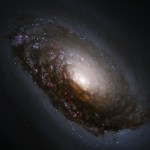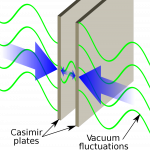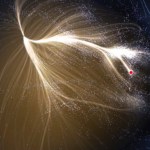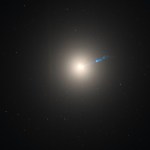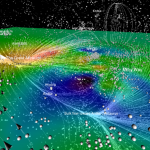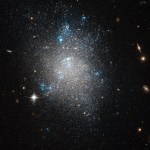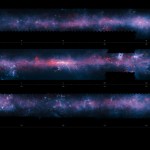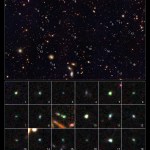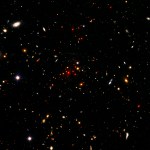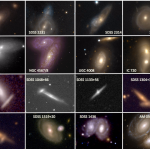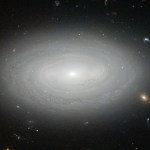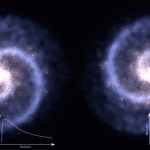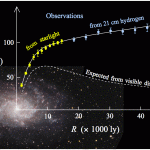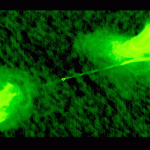Galaxies
"He ate and drank the precious Words,
his Spirit grew robust;
He knew no more that he was poor,
nor that his frame was Dust." -Emily Dickinson
When we look at spiral galaxies, we think of grand arms, star-forming regions and dust lanes lining our perspective. But unlike face-on galaxies, where everything looks the same, galaxies that appear tilted at an angle often appear to have one half far greater in its dust-richness than the other.
The Sunflower Galaxy, Messier 63, tilted relative to our line-of-sight, with one half clearly appearing dustier than the other. Image credit: ESA/Hubble…
"Another very good test some readers may want to look up... is the Casimir effect, where forces between metal plates in empty space are modified by the presence of virtual particles." -Gordon Kane
If you ask what the zero-point energy of space itself is, you can sum up all of the quantum fluctuations you can that arise in quantum field theory, and arrive at an absurd answer: 120 orders of magnitude greater than the observed. Yet if you assume that there’s an incredible cancellation and you get exactly zero, that removes the one thing our Universe needs to explain its expansion: dark energy.…
"We detect motion along this axis, but right now our data cannot state as strongly as we'd like whether the clusters are coming or going." -Alexander Kashlinsky
When dark energy was discovered, and the expansion of the Universe was shown to be accelerating, there was concurrently another puzzle that received much less attention: the problem of the Great Attractor. Galaxies appear to move due to both the Hubble expansion and the local gravitational field, but the gravity from the galaxies we saw didn’t account for all the motion.
The "flows" of galaxies mapped out with the mass field nearby.…
"Mozart's music is like an X-ray of your soul - it shows what is there, and what isn't." -Isaac Stern
When supermassive black holes have a large amount of matter fall onto them, they accelerate a large amount of the ionized material -- particularly electrons -- into high-velocity, bi-directional jets. In many cases, those jets of material collide with previously blown-off gaseous material and create high-energy X-rays.
A black hole more than a billion times the mass of the Sun powers this X-ray jet that's many thousands of light years long. Image credit: NASA / Hubble / STScI / Wikisky tool…
"The first amazing fact about gravitation is that the ratio of inertial mass to gravitational mass is constant wherever we have checked it. The second amazing thing about gravitation is how weak it is." -Richard Feynman
One of the strangest, most novel predictions of Einstein's relativity is that mass would not only curve space, but that the curved space would act like a lens. Background light traveling past this mass would become magnified, distorted and stretched. In some cases, arc, multiple images or even perfect, 360º rings would occur.
This image illustrates a gravitational lensing…
“Even when Darwin’s teaching first made its appearance, it became clear at once that its scientific, materialist core, its teaching concerning the evolution of living nature, was antagonistic to the idealism that reigned in biology.” -Trofim Lysenko
When it comes to many issues, democracy and popular opinion does and should determine the outcome. But when it comes to science and scientific issues, popular opinion or the votes of even an elite group of people doesn't mean very much at all. Instead, it's the truth that the Universe tells us about itself, through experiment, measurement and…
“The slow philosophy is not about doing everything in tortoise mode. It’s less about the speed and more about investing the right amount of time and attention in the problem so you solve it.” -Carl Honore
Einstein's theories of special and general relativity tell us that there's no Universal, preferred frame of reference. But that doesn't necessarily mean that our physical Universe doesn't have an average frame of reference, one which minimizes the relative speeds of all the galaxies to one another.
Image credit: Cosmography of the Local Universe/Cosmic Flows Project — Courtois, Helene…
“Men occasionally stumble over the truth, but most of them pick themselves up and hurry off as if nothing ever happened.” -Winston Churchill
When we look out at the Universe on the largest scales, from large-scale structure to the fluctuations in the CMB to lensed clusters of galaxies and to giant spirals and ellipticals, we find the same thing everywhere we look: dark matter outmasses normal matter by a 5-to-1 ratio. It's a finding that's independent of direction, scale or distance.
Images credit: X-ray: NASA/ CXC/UVic./A.Mahdavi et al. Optical/Lensing: CFHT/UVic./A.Mahdavi et al. (top left…
"True realism consists in revealing the surprising things which habit keeps covered and prevents us from seeing." -Jean Cocteau
Each time you look at a photograph of the Universe, you aren't just seeing it as it was at a particular moment in time, but also in a particular wavelength (or set of wavelengths) of light! Different wavelengths can reveal different phenomena and components of the Universe, from dust and gas to starlight, plasma, black holes and beyond.
The view of the galactic center in four different wavelength bands. Atop, from the ATLASGAL survey at 870 microns; below that…
"Our spectroscopic observations reveal the galaxy to be even farther away than we had originally thought, right at the distance limit of what Hubble can observe." -Gabriel Bremmer
One of the holy grails of cosmology is to measure, directly, exactly when the first stars and galaxies formed in our Universe. The Hubble Space Telescope has been pushing the distance record farther and farther back, with its measurements typically confirmed by ground-based, spectroscopic follow-ups. This time, however, the new record-holder was so distant that confirmation needed to be done from space: by Hubble…
"The wonder is, not that the field of stars of so vast, but that man has measured it." -Anatole France
If you could gather 250 million times as much light as your eye, and improve your resolution by several orders of magnitude, you just might be able to see what the Hubble Space Telescope can. By extending down into the near-infrared, and combining those observations with that from other great observatories like Chandra and Spitzer, we can probe the star-formation history of the Universe.
Image credit: NASA, ESA, the GOODS Team and M. Giavalisco (STScI/University of Massachusetts), of a…
"We are stardust, we are golden,
We are billion year old carbon,
And we got to get ourselves back to the garden." -Crosby, Stills, Nash & Young
When Charles Messier first began cataloguing nebulae, even globular clusters, just a few tens of thousands of light years distant, weren’t resolvable into individual stars. But thanks to the Hubble Space Telescope, we can see individual stars in other galaxies many millions of light years away.
Image credit: NASA, ESA and T.M. Brown (STScI), of background galaxies seen through the disk of Andromeda.
In a series of images taken from 2004-…
"Think about it this way - a boomerang goes out and comes back to you if you throw it. If you throw it out at the universe, it will come back down to you on Earth." -J. B. Smoove
Give a planet a kick, and it goes into a more distant orbit around our star. Give it a hard enough kick, and it will reach escape velocity, leaving our Solar System forever. But if you gave it an almost hard enough kick, it would travel extremely far from the Sun, but it would eventually boomerang back towards the inner Solar System, with potentially disastrous, disruptive consequences. This applies to any…
"If you take a galaxy and try to make it bigger, it becomes a cluster of galaxies, not a galaxy. If you try to make it smaller than that, it seems to blow itself apart." -Jeremiah P. Ostriker
13.8 billion years ago, the Universe as we know it was born with no stars, no clusters and no galaxies. But over time, gravitation has built up all sorts of complex structures, with the largest galaxy cluster today, El Gordo, weighing in at 3 quadrillion Suns.
The El Gordo galaxy cluster, imaged by the Hubble Space Telescope and with the dark matter mapped out. Image credit: NASA, ESA, J. Jee (…
"Gamow was fantastic in his ideas. He was right, he was wrong. More often wrong than right. Always interesting; … and when his idea was not wrong it was not only right, it was new." -Edward Teller
Considering what we know about our Universe today, it's hard to believe that just a century ago, Einstein's General Relativity was very much untested and uncertain, and we hadn't even realized that anything at all lie outside our own Milky Way. But over the past ten decades, ten great discoveries have taken place to give us the Universe we understand today.
Image credit: Adam Block/Mount…
"I know there is strength in the differences between us. I know there is comfort where we overlap." -Ani DiFranco
The observable Universe is a big, big place. Some 46 billion light years in all directions, with hundreds of billions of galaxies inside, it's no wonder that we see stars and galaxies in all directions we've ever looked. What's even more of a surprise, though, is that sometimes galaxies that aren't at all close together look like they are, and overlap.
Image credit: Sloan Digital Sky Survey / William Keel, of NGC 3861.
These optical illusions are caused by the uncommon…
"If the expansion of the space of the universe is uniform in all directions, an observer located in anyone of the galaxies will see all other galaxies running away from him at velocities proportional to their distances from the observer." -George Gamow
When Einstein put forth his space-and-time changing theory of General Relativity, one of the consequences he didn't anticipate -- and, in fact, resisted -- was the fact that a static Universe would be unstable, and that the Universe must be either expanding or contracting. While the theoretical work of many, such as de Sitter, Friedmann and…
"The farther we peer into space, the more we realize that the nature of the universe cannot be understood fully by inspecting spiral galaxies or watching distant supernovas. It lies deeper." -Robert Lanza
When you take a look at a spiral galaxy in the night sky, it seems obvious that the stars on the inner parts of the galaxy are going to orbit in less time than the stars in the outer part. This turns out to be true, something we've figured out even though the timescales for galaxies to complete a full revolution are far longer than we've ever been able to observe.
Image credit: ESO, taken…
"A dwarf standing on the shoulders of a giant may see farther than a giant himself." -Robert Burton
Both the internal motions of individual galaxies and the wholesale motions of galaxies within clusters require much more mass than normal matter — protons, neutrons and electrons — can account for: about five times as much. Because this can't be any of the Standard Model particles, and it can't interact either electromagnetically or with the nuclear forces, we refer to it as dark matter.
Image credit: Wikimedia Commons user Stefania.deluca.
But oddly enough, the smallest galaxies exhibit…
"Twinkle, twinkle quasi-star.
Biggest puzzle from afar.
How unlike the other ones.
Brighter than a billion suns.
Twinkle, twinkle, quasi-star.
How I wonder what you are." -George Gamow
One of the most interesting classes of objects in the entire sky is one that's invisible to the naked eye, yet appears brighter than anything else in radio wavelengths: the quasar. Originally coined as an acronym (QSRS) for Quasi-Stellar Radio Source, these were later determined to be incredibly energetic sources of accelerated matter powered by a supermassive black hole.
Image credit: Aurore Simonnet, NASA /…
